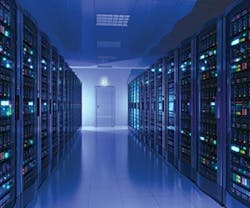Sustainable Data Centers Can Drastically Slash Emissions
Most big data centers could slash their greenhouse gas emissions by 88%, according to new Stanford research. Simply by switching to efficient, off-the-shelf equipment and improving energy management, data centers could be significantly more sustainable.
Carbon emissions from data centers are primarily related to three things: the computing efficiency of equipment like servers, storage, and network switches; the amount of electricity a data center’s building uses for functions other than computing, primarily cooling; and how much of that energy comes from renewable or low-carbon sources.
Although adding renewable power can reduce a data center’s emissions by 98% when combined with other strategies, improving the efficiency of IT devices is overwhelmingly the most important measure, says Jonathan Koorney, research fellow at Stanford and co-author of Characteristics of Low-Carbon Data Centers, a study recently published in Nature Climate Change.
The processors in most server farms operate at just 3-5% of their maximum capacity, Koorney notes. Server virtualization, consolidation, and better software can increase utilization to 30% and sometimes as high as 80%. Other ways to avoid wasting electricity include faster computers that quickly pay for themselves and using flash memory on the motherboard instead of hard disks.
Motivated by cost of electricity, publicity, and pressure from environmental organizations, most big companies like Facebook, Google, and Amazon have already taken such measures. At organizations where computing is not the main function, efficiency has suffered.
Department heads at such organizations typically want to keep control of their servers rather than centralize, which eliminates most potential optimization. And the managers who order and operate the equipment are often not accountable for energy costs or efficiency – a major institutional barrier to sustainable computing.
“The utilities and IT departments have separate budgets, and neither operates with the goal of saving the company money overall,” said Koomey. “The IT people don’t care about putting in an efficient server, because they don’t pay the electric bill. Once you fix the institutional problems, then the company can move quickly, because the needed equipment is off-the-shelf and the energy management practices are well understood.”
After IT equipment, the second major way to reduce emissions is to improve the efficiency of the buildings. A key measurement is the ratio of electricity used to perform computations to the amount of power consumed for secondary support, like cooling and monitoring systems. Typically that ratio is about 1 kWh for computing to 0.8 kWh for the facility.
State-of-the-art data centers have reduced the ratio to about 1/0.1 kWh, the study notes. They have located server farms in cool climates, purchased processors less sensitive to heat, and use efficient air-flow management.
However, policymakers and environmental organizations tend to focus on renewable energy, which is a misplaced priority, notes the study.
“For data centers, as for all uses of energy, efficiency is always the first thing to do,” says Eric Masanet, researcher at Northwestern University and co-author. “It’s cheapest and allows you to get more mileage out of your equipment.”
